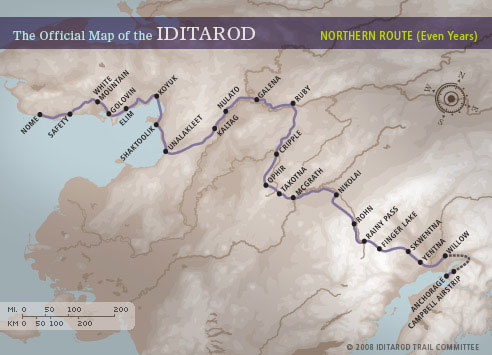Visit the Official Iditarod Web Site
The Last Great Race on Earth
You can’t compare it to any other competitive event in the world! A race over 1150 miles of the roughest, most beautiful terrain Mother Nature has to offer. She throws jagged mountain ranges, frozen river, dense forest, desolate tundra and miles of windswept coast at the mushers and their dog teams. Add to that temperatures far below zero, winds that can cause a complete loss of visibility, the hazards of overflow, long hours of darkness and treacherous climbs and side hills, and you have the Iditarod. A race extraordinaire, a race only possible in Alaska.
The race pits man and animal against nature, against wild Alaska at her best and as each mile is covered, a tribute to Alaska’s past is issued. The Iditarod is a tie to – a commemoration of – that colorful past.
Anchorage is the starting line – a city of over 250,000 people, street lights, freeways and traffic. From there the field of dog teams which grow in number each year, runs to Eagle River, Checkpoint # 1. After a restart in the Matanuska Valley at Wasilla, the mushers leave the land of highways and bustling activity and head out to the Yentna Station Roadhouse and Skwentna and then up! Through Finger Lake, Rainy Pass, over the Alaska Range and down the other side to the Kuskokwim River – Rohn Roadhouse, Nikolai, McGrath, Ophir, Cripple, Iditarod and on to the mighty Yukon – a river highway that takes the teams west through the arctic tundra.
The race route is alternated every other year, one year going north through Cripple, Ruby and Galena, the next year south through Iditarod, Shageluk, Anvik.
Finally, they’re on the coast – Unalakleet, Shaktoolik, Koyuk, Elim, Golovin, White Mountain and into Nome where a hero’s welcome is the custom for musher number 1 or 61!
The route encompasses large metropolitan areas and small native villages. It causes a yearly spurt of activity, increased airplane traffic and excitement to areas otherwise quiet and dormant during the long Alaskan winter. Everyone gets involved, from very young school children to the old timers who relive the colorful Alaskan past they’ve known as they watch each musher and his team. The race is an educational opportunity and an economic stimulus to these small Alaskan outposts.
Iditarod Trail Map


